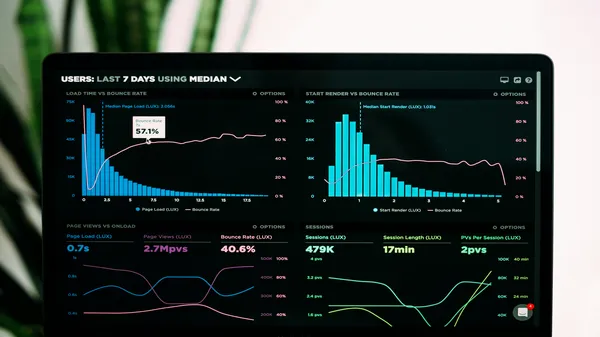Understanding market trends is like reading a map to navigate the financial landscape. Whether you’re an active trader or a long-term investor, mastering trend analysis can be your secret weapon in making informed decisions. In this detailed guide, we’ll explore what trend analysis is, why it matters, and the different types of market trend strategies that can help you ride the wave of market momentum. By the end, you'll be equipped with practical insights and step-by-step strategies to analyze market movements with confidence.
What is Trend Analysis and Why is it Crucial?
Trend analysis is the art and science of tracking prices and market behavior to forecast future movements. At its core, trend analysis allows you to see financial markets as a whole, rather than getting lost in day-to-day fluctuations. It's a way to separate the signal from the noise in the marketplace.
Imagine you're hiking in a vast forest full of unclear paths. Without clear markers, it’s easy to get lost. Trend analysis takes on the role of those markers, helping you pinpoint the direction – whether markets are in a bullish climb, bearish descent, or moving sideways. This understanding is critical because:
- Risk Management: The better you understand market trends, the more you can protect your capital from sudden reversals.
- Informed Decisions: By identifying trends, your trading or investment decisions are backed by data, not mere speculation.
- Opportunity Identification: Trends reveal periods when entering or exiting trades might be most advantageous.
Breaking Down the Types of Market Trends
Market trends typically fall into three categories: upward, downward, and sideways. Each trend type requires a different approach and has its unique characteristics.
1. Upward (Bullish) Trends
- Definition: In an upward trend, prices consistently rise. It signals optimism among investors with accumulating buying pressure.
- What to Look For: Higher highs and higher lows form the classic pattern of an uptrend. Indicators such as moving averages often move upward.
- Strategies: Consider long positions during these periods. Techniques like "buy the dip" can allow you to capitalize on temporary pullbacks before the upward momentum resumes.
2. Downward (Bearish) Trends
- Definition: A downward trend is marked by consistently falling prices, often caused by widespread pessimism or negative economic news.
- What to Look For: Lower highs and lower lows define the bearish pattern. Technical indicators like Relative Strength Index (RSI) might also indicate oversold conditions.
- Strategies: Short selling, protective stops, and hedging are common strategies in bearish markets. It’s vital to keep risk tightly controlled during these periods.
3. Sideways (Range-Bound) Trends
- Definition: In sideways trends, prices oscillate within a defined range. Often due to market indecision, these trends signal a period of consolidation.
- What to Look For: Watch for clear support and resistance levels. Volume might decrease, and technical oscillators may bounce between extremes.
- Strategies: Range trading can be effective here. This involves buying near support levels and selling near resistance levels, while also using breakout strategies when the market eventually moves out of range.
Tools and Techniques for Effective Trend Analysis
Several tools and techniques can simplify the process of trend identification and validation. Let’s walk through some of the most commonly used instruments and methods:
Moving Averages
Moving averages smooth out price data to help you visualize the trend more clearly. There are several types:
- Simple Moving Average (SMA): This is the average price over a selected period, providing a straightforward, unweighted view of the price.
- Exponential Moving Average (EMA): EMA gives more weight to recent prices, making it more responsive during volatile periods.
Using moving averages, a trader might look for a crossover signal—for instance, when a short-term average (like the 10-day EMA) crosses above a long-term average (like the 50-day SMA), it could indicate a bullish reversal.
Trend Lines and Channels
Drawing trend lines on a chart can be incredibly useful. A trend line connects significant lows in an uptrend or highs in a downtrend. Channels form when you draw a parallel line to the trend line, marking potential support or resistance levels.
Technical Indicators
Indicators such as the Moving Average Convergence Divergence (MACD), the RSI, and Bollinger Bands are invaluable allies in trend analysis. They can confirm if the trend you are seeing is statistically significant or simply a temporary fluctuation.
- MACD: Helps in identifying momentum and potential reversals.
- RSI: Measures the speed and change of price movements and highlights overbought or oversold conditions.
- Bollinger Bands: Show volatility by displaying standard deviations away from a moving average.
Chart Patterns
Familiarizing yourself with common chart patterns—like head and shoulders, double tops, double bottoms, and triangles—can further enhance your ability to predict trend reversals or continuations. These patterns bring a narrative to the chaotic series of price movements.
Building Market Trend Strategies: Step by Step
Now that we understand the basics of trend analysis, let’s delve into creating market trend strategies that are actionable and effective.
Step 1: Establish Your Time Frame
Every trader or investor should begin by determining the time horizon that aligns with their goals. Different strategies work best on different time frames:
- Short-term Trading: Day traders or swing traders often focus on minute-by-minute or daily trends. Rapid analysis and quick decision-making are crucial.
- Long-term Investing: For long-term investments, weekly or monthly trends are more relevant, reducing the impact of short-term noise.
Step 2: Identify the Trend
Using the tools discussed above, identify the current market trend. Ask these critical questions:
- Is the trend upward, downward, or sideways?
- What is the strength of the trend? (For example, are there solid higher highs or lower lows?)
- How has the trend performed historically during similar market conditions?
This diagnostic step provides the foundation for selecting an appropriate strategy.
Step 3: Select Your Entry and Exit Points
A successful trend strategy depends on precise timing. Establish clear rules for your entry and exit points based on your analysis.
- Entry Points: For bullish trends, consider entering after a pullback near the support level provided by a moving average or trend line. For bearish trends, look for opportunities near resistance, especially after a failed rally.
- Exit Points: Protective stop-loss orders are vital to limit downside. Additionally, defining profit targets based on resistance levels or projected trend extents ensures you lock in gains.
Step 4: Manage Risk Rigorously
Risk management is the cornerstone of trend strategies. No matter how clear a trend you might see, unexpected reversals can happen. Always employ risk control measures such as:
- Stop-Loss Orders: These orders automatically close a position if the price moves against you.
- Position Sizing: Never risk more than a small percentage of your total capital on a single trade.
- Diversification: Avoid putting all your funds into one asset or market trend.
Step 5: Monitor and Adjust
Markets can change rapidly. A trend that appears robust in the morning could show signs of reversal by afternoon. Continue monitoring your positions closely and be prepared to adjust your plan as new data is released.
Keeping a trading journal can be incredibly beneficial. Document your trades, the rationale behind your decisions, and the outcome. Over time, this can highlight which strategies work best in specific types of market conditions.
Advanced Trend Analysis Strategies
With the basics covered, let’s explore some advanced strategies used by experienced traders to refine their market trend analysis:
Dollar-Cost Averaging in Trending Markets
Percentages and averages matter most over long periods. Dollar-cost averaging (DCA) isn’t just for long-term investors—it can be adapted to trending markets. For instance, consistently buying during an uptrend can help smooth out volatility while still riding the increasing tide.
Trend Reversal Detection
Sometimes, trends do change course, and detecting these reversals early is key to preserving profits. Advanced traders monitor divergence in indicators like MACD or RSI, which may suggest that the current trend is losing momentum. Other techniques include:
- Volume Analysis: A spike in trading volume can indicate a potential reversal.
- Support and Resistance Breaks: Identifying breaches in long-established levels can signal a shift in market psychology.
Using Multiple Time Frame Analysis
Multiple time frame analysis involves looking at higher time frames alongside your specific chart. For example, if you're trading on the daily chart, also review the weekly chart for a broader market context. Often, even if a daily chart shows an uptrend, a weekly chart might signal an impending reversal. This layered view reduces the risk of misinterpreting short-term market noise.
Combining Technical and Fundamental Analysis
While trend analysis is primarily technical, overlaying fundamental insights can give you a clearer picture. Economic data, geopolitical events, and earnings reports often drive the underlying market sentiment that forms the basis of observable trends. For instance, a bullish trend in a stock might be validated by strong quarterly earnings and positive industry forecasts.
Personal Anecdote: Navigating Market Trends
I remember a time when I ventured into swing trading without a clear understanding of trend analysis. I were caught off guard by a sudden market reversal after a long period of bullish momentum. What could have been a significant profit turned into a stark lesson. Since then, I adopted a disciplined approach by combining multiple technical indicators with a solid risk management strategy. The result? A more resilient trading approach that respects market movements without overcommitting.
This personal experience reinforces that even in volatile markets, a well-honed trend analysis strategy allows one to stay in control, adapt to changes, and ultimately benefit from the market’s natural cycle of highs and lows.
Integrating Trend Analysis with a Broader Trading Plan
Trend analysis should never be viewed as a standalone element in your trading arsenal. Instead, integrate it into a broader, holistic strategy that considers different market conditions and individual risk tolerance. Here are a few steps to weave trend analysis into a comprehensive trading plan:
- Set Clear Objectives: Define what success looks like for each trade or investment. Are you looking for a quick profit from short-term moves, or are you building a long-term position?
- Utilize Consistent Methodologies: Regularly use methods like moving averages, trend lines, and volume analysis to assess market conditions.
- Review and Refine: The market changes over time, and so should your strategies. Regularly reviewing your performance and adjusting your approach can help you stay on the path to success.
- Educate Continuously: Markets evolve and so does technology. Stay updated by following reliable financial news, participating in trading forums, and taking courses on advanced technical analysis.
Final Thoughts: Empower Your Trading Journey
In today’s ever-evolving financial markets, understanding and applying trend analysis can be a game-changer. This comprehensive guide has walked you through the fundamentals and advanced strategies of market trend analysis—from identifying rising, falling, and sideways trends to implementing precise entry and exit strategies with effective risk management.
Whether you're an experienced trader or a curious beginner, remember that the key to success lies in a disciplined approach to analyzing market trends. Leverage the tools and techniques discussed here, integrate them into your trading plan, and continuously refine your strategy based on market feedback.
By mastering the art of trend analysis, you’re not just reacting to the market—you’re anticipating its moves. And with every informed decision, you take one step closer to unlocking your full trading potential.
Happy trading, and may your strategies be both profitable and resilient in the face of market uncertainties!




.webp)

.webp)



.webp)
.webp)
.webp)
.png)